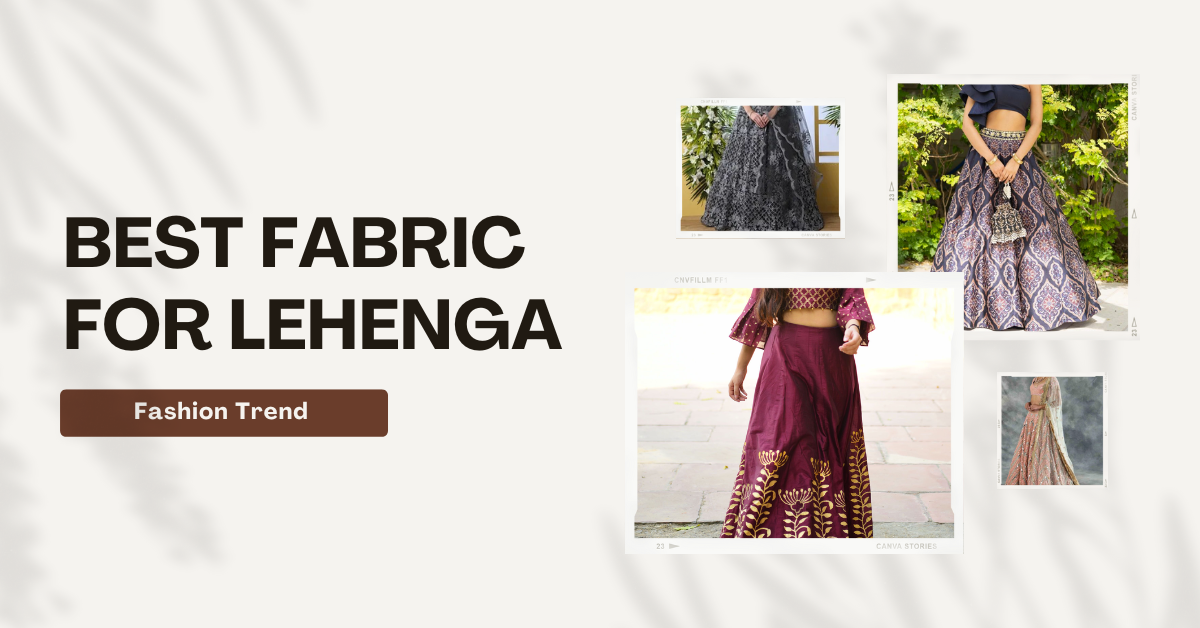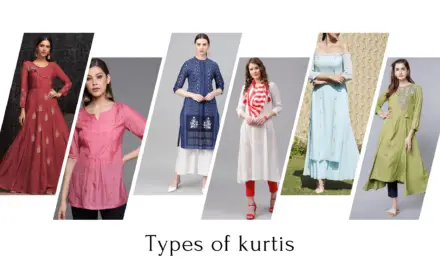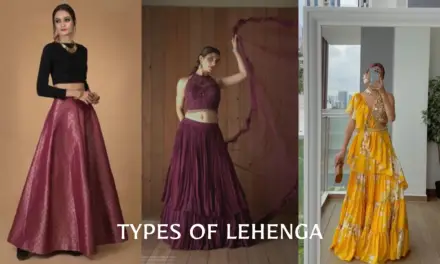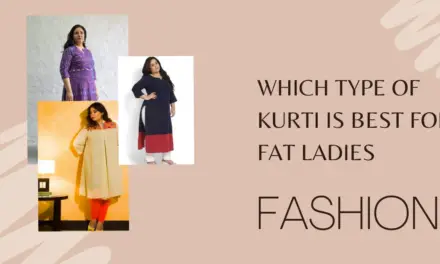Which is the Best Fabric for Lehenga? Indian weddings are approaching! Millions of brides and grooms choose to purchase lehengas for weddings. It is tough to pick a good fabric and a designer from the wide variety available on the market. Is it possible if me to have shoes that are not fitting my physique?
What if we spend a lot of money and do not even love it? To avoid this situation, it is essential that you research before purchasing any Lehengas. This guide is designed to assist you with choosing the most appropriate Lehengas material online. note if you are thinking to buy a readymade Lehenga, always go with branded one.
There are many different fabrics that can be used to make a lehenga, each with its own unique properties and uses. Here is a list of some common fabrics used for lehengas, along with their uses:
| Fabric | Uses |
|---|---|
| Silk | Formal events, weddings, parties |
| Georgette | Parties, formal events |
| Chiffon | Parties, formal events |
| Velvet | Weddings, formal events, parties |
| Net | Parties, formal events |
| Brocade | Weddings, formal events, traditional occasions |
| Satin | Formal events, parties, special occasions |
| Crepe | Parties, formal events |
| Cotton | Casual wear, everyday wear |
Keep in mind that these are just a few examples, and there are many other fabrics that can be used
Table of Contents
Choosing Lehenga Colours and Fabrics
A lehenga is a traditional Indian garment that consists of a skirt, a blouse, and a scarf. When choosing a lehenga, there are several factors to consider, including color, fabric, and style. Here is a step-by-step guide to help you choose the perfect lehenga for your occasion:
- Consider the occasion: The first step in choosing a lehenga is to consider the occasion. Is it a wedding, a formal event, or a casual party? The type of event will help you narrow down your choices and decide on an appropriate color and style.
- Choose a color: Lehengas are available in a wide range of colors, from vibrant shades to more muted tones. When choosing a color, consider your skin tone and the color of your eyes. Some colors that tend to look good on most skin tones include red, orange, green, and gold.
- Consider the fabric: Lehengas can be made from a variety of fabrics, including silk, chiffon, georgette, and crepe. Each fabric has its own unique properties, so it’s important to consider the type of fabric that will be most suitable for the occasion. For example, silk is a more formal fabric, while chiffon is lighter and more suitable for summer events.
- Think about the style: Lehengas are available in a range of styles, from traditional to contemporary. Consider the style of the event and your personal style when choosing a lehenga. For example, a traditional lehenga with heavy embroidery and intricate details may be more suitable for a wedding, while a simpler, more modern style may be more suitable for a casual party.
- Try on different styles: Once you have an idea of the color, fabric, and style you prefer, it’s a good idea to try on different lehengas to see what looks and feels best on you. This will help you get a better sense of which lehenga is the most flattering and comfortable for you.
How can you nail that perfect lehenga fabric for your wedding?
Choosing the perfect fabric for your wedding lehenga is an important decision, as the fabric can greatly affect the overall look and feel of the garment. Here are a few tips to help you nail the perfect lehenga fabric for your wedding:
- Consider the season: The type of fabric you choose should be appropriate for the season of your wedding. For example, if you’re having a summer wedding, you may want to opt for a lighter fabric like chiffon or georgette, which will be more comfortable and breathable. On the other hand, if you’re having a winter wedding, you may want to choose a heavier fabric like silk or brocade, which will provide more warmth.
- Think about the style: The fabric you choose should also be appropriate for the style of your lehenga. For example, if you’re going for a traditional, heavily embroidered lehenga, you may want to choose a sturdy fabric like silk or velvet, which will hold up well under the weight of the embroidery. On the other hand, if you’re going for a more modern, minimalistic style, you may want to choose a lighter, more flowing fabric like chiffon or georgette.
- Consider the venue: The venue of your wedding can also influence the type of fabric you choose. If you’re having an outdoor wedding, you may want to choose a fabric that is more resistant to wind and moisture, such as silk or satin. On the other hand, if you’re having an indoor wedding, you may have more flexibility in terms of fabric choice.
- Think about comfort: Remember that you’ll be wearing your lehenga for a long period of time on your wedding day, so it’s important to choose a fabric that is comfortable to wear. Consider factors like the weight of the fabric, the drape, and the feel against your skin when making your decision.
Lightweight & Comfortable fabrics
There are several lightweight and comfortable fabrics that can be used for lehengas or other garments. Some of these fabrics include:
- Chiffon: Chiffon is a lightweight, sheer fabric that is made from silk or synthetic fibers. It is known for its soft, flowing drape, which makes it a popular choice for dresses and skirts. Chiffon is also easy to care for and resistant to wrinkling, making it a practical choice for everyday wear.
- Georgette: Georgette is a lightweight, sheer fabric that is made from silk or synthetic fibers. It is similar to chiffon, but it has a slightly more textured, crinkled appearance. Georgette is known for its smooth, flowing drape and is often used for formal wear.
- Crepe: Crepe is a lightweight fabric with a crinkled or textured appearance. It is made from silk, wool, or synthetic fibers and is known for its soft, matte finish and easy drape. Crepe is a versatile fabric that can be dressed up or down and is suitable for both casual and formal occasions.
- Cotton: Cotton is a lightweight, breathable fabric that is made from natural fibers. It is known for its soft, comfortable feel and is a popular choice for everyday wear. Cotton is also easy to care for and resistant to wrinkling, making it a practical choice for lehengas and other garments.
Choose Lehenga Fabrics according to daytime or evening time
When choosing a lehenga fabric, it’s important to consider the time of day the event will take place. Here are a few tips for choosing lehenga fabrics according to the time of day:
- Daytime events: For daytime events, you may want to choose a lighter, more breathable fabric like chiffon, georgette, or cotton. These fabrics will be more comfortable to wear in the heat of the day and will help keep you cool. You may also want to choose a fabric with a more casual or relaxed drape, such as linen or gauze, for a daytime event.
- Evening events: For evening events, you may want to choose a more formal fabric like silk, satin, or velvet. These fabrics are luxurious and have a more formal drape, which is suitable for a formal event. You may also want to consider a fabric with a bit of shine or sparkle, such as sequined or beaded fabrics, for an evening event.
- Outdoor events: If you’re having an outdoor event, you’ll want to choose a fabric that is appropriate for the weather. For example, if it’s a hot day, you may want to choose a lightweight, breathable fabric like chiffon or georgette. If it’s a cooler day, you may want to choose a heavier fabric like silk or brocade to keep you warm. You’ll also want to consider a fabric that is resistant to wind and moisture, such as silk or satin.
Choose fabric according to your body size
The fabric of your lehenga can greatly affect the overall look and fit of the garment. Here are a few tips for choosing a lehenga fabric according to your body size:
- If you’re petite: If you’re petite, you may want to choose a lighter fabric like chiffon or georgette, which will drape nicely and not add unnecessary bulk to your frame. Avoid heavy fabrics like silk or brocade, which may overwhelm your frame.
- If you’re plus-size: If you’re plus-size, you may want to choose a fabric that has a bit more structure, such as silk or satin. These fabrics will help define your curves and create a more flattering silhouette. Avoid lightweight, flowing fabrics like chiffon or georgette, which may add volume and make you look larger.
- If you’re tall: If you’re tall, you can generally wear most types of fabrics without issue. However, you may want to avoid very heavy fabrics like velvet or brocade, which may weigh you down and make you look shorter.
Choosing Lehenga Fabric by Season
lehenga. Here are a few tips for choosing a lehenga fabric by season:
- Spring and summer: For spring and summer events, you may want to choose a lighter, more breathable fabric like chiffon, georgette, or cotton. These fabrics will help keep you cool and comfortable in warmer weather. You may also want to consider a fabric with a more relaxed or casual drape, such as linen or gauze.
- Fall and winter: For fall and winter events, you may want to choose a heavier, more substantial fabric like silk, satin, or velvet. These fabrics will provide more warmth and will be more appropriate for the cooler weather. You may also want to consider a fabric with a bit of shine or sparkle, such as sequined or beaded fabrics, for a festive touch.
- Outdoor events: If you’re having an outdoor event, you’ll want to choose a fabric that is appropriate for the weather. For example, if it’s a hot day, you may want to choose a lightweight, breathable fabric like chiffon or georgette. If it’s a cooler day, you may want to choose a heavier fabric like silk or brocade to keep you warm. You’ll also want to consider a fabric that is resistant to wind and moisture, such as silk or satin.
Fabric selection based on skin color
The color of your skin can also influence the type of fabric you choose for your lehenga. Here are a few tips for choosing a lehenga fabric based on your skin color:
- Fair skin: If you have fair skin, you may want to choose a fabric that contrasts with your skin tone. For example, if you have pale skin, you may want to choose a fabric in a bold, vibrant color like red or emerald green. These colors will help create a striking contrast with your skin and will make you stand out.
- Medium skin: If you have medium skin, you have more flexibility in terms of fabric choice. You can choose fabrics in lighter or darker shades that complement your skin tone. For example, you may want to choose a fabric in a softer, more muted color like pastel pink or powder blue. Alternatively, you may want to choose a fabric in a rich, deep shade like burgundy or navy.
- Dark skin: If you have dark skin, you may want to choose a fabric in a color that complements your skin tone. For example, you may want to choose a fabric in a bold, vibrant color like fuchsia or turquoise, which will stand out against your dark skin. Alternatively, you may want to choose a fabric in a softer, more muted color like peach or light green, which will provide a nice contrast without overwhelming your skin.
Selecting the right fabric for your lehenga
There are several factors to consider when choosing the right fabric for your lehenga. Here are a few tips to help you select the perfect fabric:
- Consider the occasion: The type of event you’ll be attending will influence the type of fabric you choose. For example, if you’re attending a formal event, you may want to choose a more luxurious fabric like silk or satin. On the other hand, if you’re attending a casual event, you may want to choose a more relaxed fabric like cotton or linen.
- Think about the season: The season of your event can also influence your fabric choice. For example, if you’re attending a summer event, you may want to choose a lighter, more breathable fabric like chiffon or georgette. On the other hand, if you’re attending a winter event, you may want to choose a heavier, more substantial fabric like silk or velvet.
- Consider your body type: The fabric you choose should also be appropriate for your body type. For example, if you’re petite, you may want to choose a lighter fabric like chiffon or georgette, which will drape nicely and not add unnecessary bulk. On the other hand, if you’re plus-size, you may want to choose a fabric that has a bit more structure, such as silk or satin, to help define your curves.
- Think about comfort: Remember that you’ll be wearing your lehenga for a long period of time, so it’s important to choose a fabric that is comfortable to wear. Consider factors like the weight of the fabric, the drape, and the feel against your skin when making your decision.
Lehenga Fabric by Location
The location of your event can also influence the type of fabric you choose for your lehenga. Here are a few tips for choosing a lehenga fabric by location:
- Indoor events: If you’re attending an indoor event, you have more flexibility in terms of fabric choice. You can choose a fabric that is appropriate for the occasion and the season, such as silk or satin for a formal event or chiffon or georgette for a summer event.
- Outdoor events: If you’re attending an outdoor event, you’ll want to choose a fabric that is appropriate for the weather. For example, if it’s a hot day, you may want to choose a lightweight, breathable fabric like chiffon or georgette. If it’s a cooler day, you may want to choose a heavier fabric like silk or brocade to keep you warm. You’ll also want to consider a fabric that is resistant to wind and moisture, such as silk or satin.
- Tropical locations: If you’re attending an event in a tropical location, you may want to choose a fabric that is light and airy, such as chiffon or georgette. These fabrics will help keep you cool and comfortable in the humid climate. Avoid heavy fabrics like silk or velvet, which may be too warm and uncomfortable in a tropical location.






Recent Comments